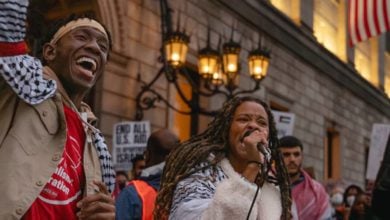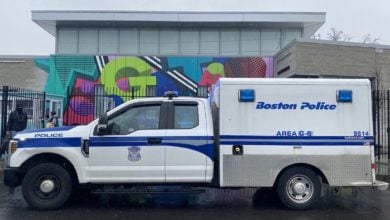Over a thousand people gathered at Cole’s Hill in Plymouth, Mass., on Nov. 26, eager to hear Indigenous speakers for the 52nd National Day of Mourning. Fall breezes held the scent of burning sage from the smudge sticks of elders, accompanied by the bellowing of a conch shell and the beat of drums. The crowd included families, movement leaders, supporters of the Wampanoag, and other Native peoples, and was led by the United American Indians of New England.
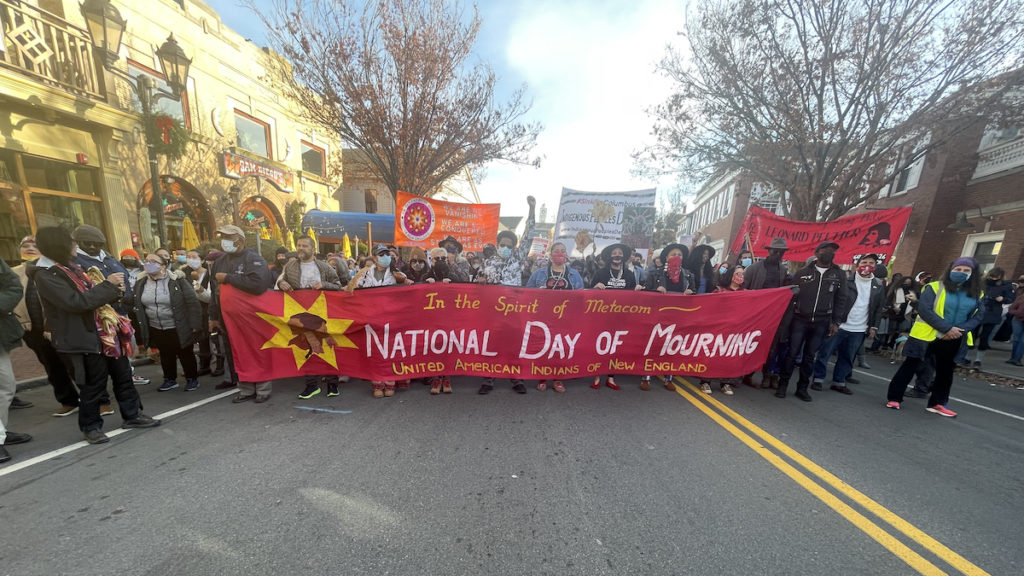
The National Day of Mourning is a day that acknowledges the genocide of Indigenous peoples and theft of their land, but also reaffirms their strength, spirituality and solidarity. It is a day that rejects the myths of the past surrounding Thanksgiving and highlights the issues Indigenous people currently face, such as climate change, missing and murdered Indigenous women, mass graves of Native children, and local struggles including the MA Indigenous Agenda. The live streamed event commemorated the day with fasting, dances, prayer ceremonies, a march with speakers along the route, and calls to action.
‘We are as strong as ever‘
“Many of the elders who stood on this hill and organized the first National Day of Mourning are no longer with us, but we feel their spirits guiding us today,” Kisha James told the crowd. James is an enrolled member of the Wampanoag Tribe of Gay Head (Aquinnah) and Oglala Lakota, archivist, and union member. “Today, we mourn the loss of Wampanoag elder, UAINE co-leader, Moonanum James who joined the ancestors in December of last year. And Wampanoag elder Bert Waters, who entered the spirit world in August of this year.”
Kisha James also told the story of the National Day of Mourning and its origins. In 1971, her grandfather Wamsutta Frank James refused to water down the truth of his speech to appease local officials. Kisha ended her own speech echoing the words on the orange UAINE banner behind her: “We are not vanishing, we are not conquered, we are as strong as ever.”
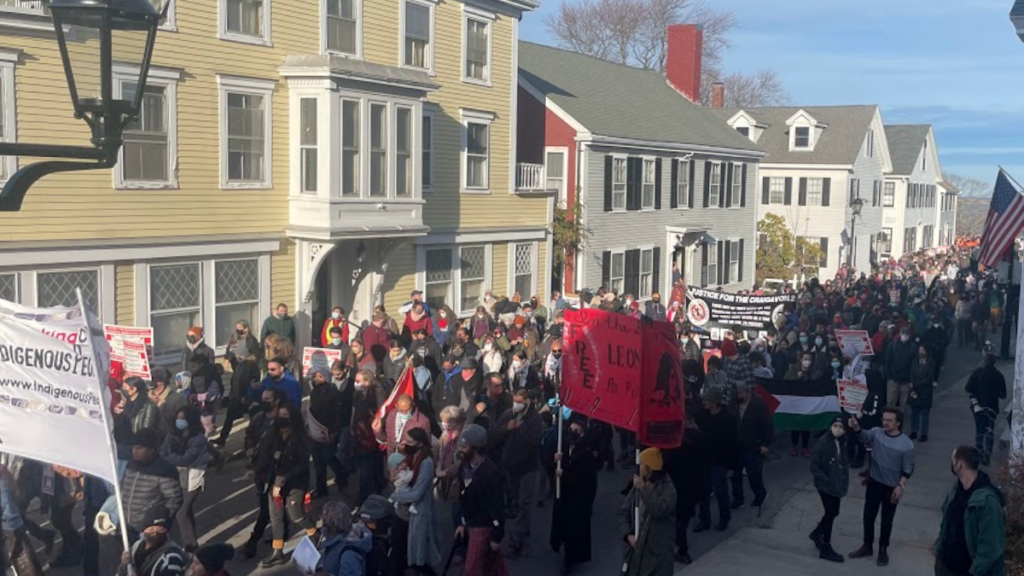
Melissa Harding Ferretti of the Herring Pond Wampanoag Tribe said, “We have called this land home for thousands of years. Our ancestors are buried here and our descendants can still be found here today. … We are proud, resilient, and powerful people, well aware of our history here.”
UAINE co-leader Mahtowin Munro acknowledged those who traveled far, including the buses of Haitian community members from Brooklyn, of Borinquen and Taíno people who left from Yankee stadium, and the large Palestinian contingent present.
‘Bring the children home!’
Earlier this year, more than 7,000 children were found buried in unmarked graves at Canadian residential schools with still more locations to search. Survivors of the so-called ‘schools’ have long said there were mass graves, but there was no government action. In the United States, the Interior Department has said they will also search for children’s graves. “We can not rest until this happens! Bring the children home!” cried out Munro.
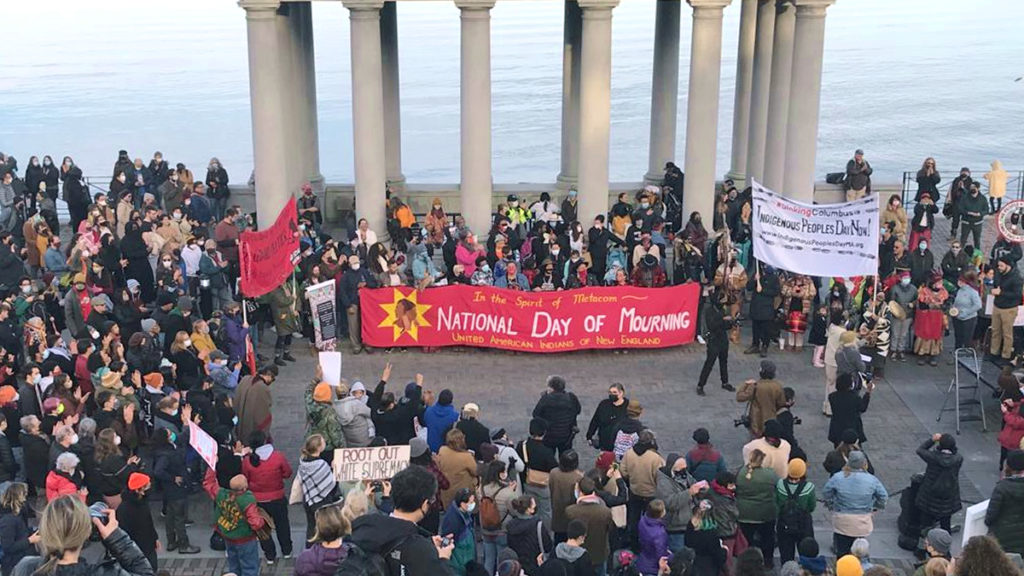
She said that similar schools in Latin America, India, and elsewhere continue to strip Indigenous children of family and cultural ties. Munro compared these dangers to the foster care system of the United States and Canada:
“Evangelicals and right-wing organizations like the Goldwater Institute, have been leading the charge to get rid of the Indian Child Welfare Act. That’s the only thing preventing our children from being wholesale adopted out of their own communities. These groups want to push us back to the 1960s when at least a third of Indigenous children were stolen from their families and put into white homes, losing their tribal connections and cultures.”
‘Free Leonard Peltier!’
Those who have fought for Indigenous freedom are still unjustly locked behind bars. Herb Waters IV, grandson of Dr. Herbert Waters, Jr., read a recent statement from political prisoner Leonard Peltier describing his struggles and declining health. “I remain grateful for the gift of life,” Peltier wrote.
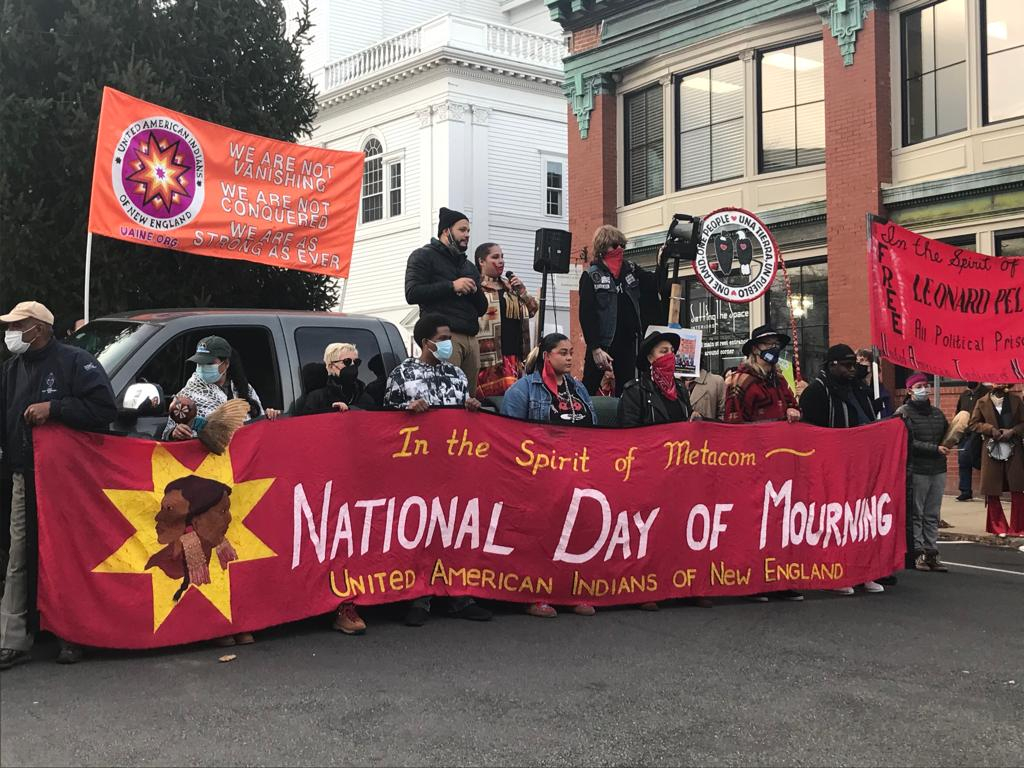
Munro implored the audience to take action to help free Peltier and go to whoisleonardpeltier.info for further information. There is renewed hope coming from a clemency request letter addressed to President Joe Biden and written by former U.S. Attorney James Reynolds, who put Leonard behind bars and now admits the sentencing “was and is unjust.”
Protesting the destruction of the environment
As the march passed restaurants and gift shops on colonized Wampanoag land, Chali’naru Dones, a Taíno-Boricua woman in traditional Taíno clothing, held aloft a conch shell and a bird’s wing attached to a leather handle.
When the march reached Plymouth Rock, Ayeta Aronson, a member of the United Houma Nation who lives in Lafourche Parish in Louisiana, criticized the hypocrisy of the Biden administration who attended COP26 and days later sold 88 million acres of Gulf Coast waters to offshore oil drilling. She also pointed out that Secretary of the Interior Deb Haaland could have put a hold on it.
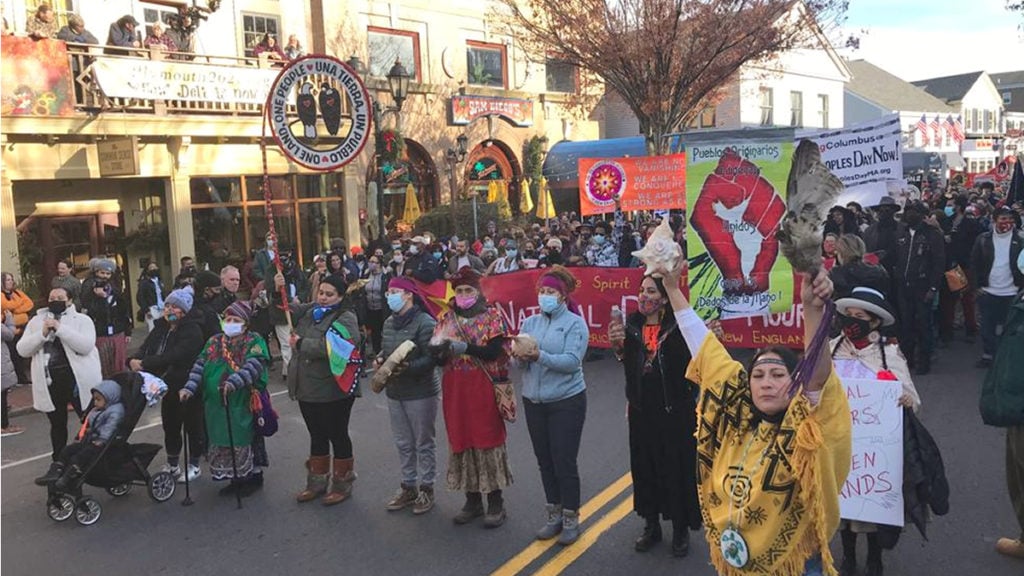
Living in a so-called “sacrifice zone,” Aronson’s community is retaliated against when they try to be heard. After all, the police station she passes by on her way to work reads: “State police division, sponsored by Shell.”
Aronson also criticized the lack of a proper hurricane response and issues such as raw sewage on the street for a week, which has poisoned fresh water and closed nearby fisheries. She then read a list of demands and connected people to resources and organizations for impacted communities in need of support.
‘No more stolen sisters!’
With the sun slowly setting, the crowd marched to Post Office Square, a site with a plaque commemorating Metacomet, a Wampanoag leader who encouraged Native people in New England to defend themselves against the European colonizers. The year-long King Phillip’s War ended with Metacomet’s murder, and his head was displayed on a pike at this location for more than 20 years as a warning. His wife and son were sold into slavery.
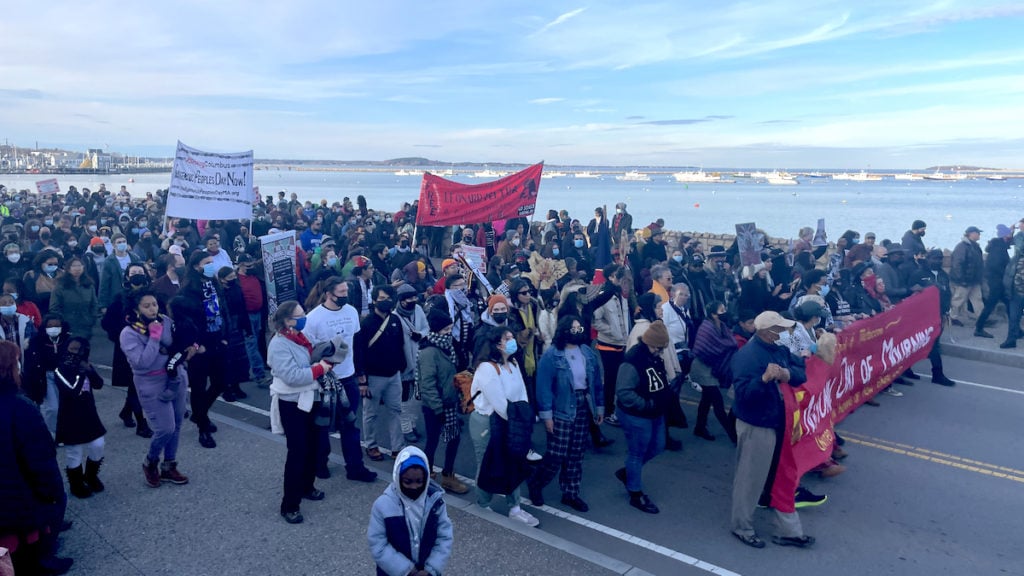
Rebecca Lodgepole, a member of the Chippewa Cree Tribe, stood with a red hand print over her mouth, a visual symbolic of the Indigenous women and girls who have gone missing. Lodgepole demanded accountability for the murders of her missing uncle and sister: “Today is one of those days where there’s a lot of people who finally acknowledge us, who want to understand our pain and suffering, who want to hear our voices.” She described the genocide of missing and murdered Indigenous women starting with Pocahantas, who was “not just a princess [but] a captive of war.”
“We will never have the radical change that we need for this planet, talking about climate justice, talking about racial justice, talking about economic justice, until the nation states finally honor the rights of Indigenous peoples,” said Jean-Luc Pierite, from the Tunica-Biloxi Tribe of Louisiana and President of the North American Indian Center of Boston. “The mourning we do today should erupt in actions, not guilt!”
Read previous coverage from Liberation News of The National Day of Mourning and Leonard Peltier here:
‘Freedom Riders’ demand release of political prisoner Leonard Peltier, 2021
La Riva: My visit with Leonard Peltier, 2020
ANSWER Statement at 50th Annual Day of Mourning, 2019
Day of Mourning Statement by Leonard Peltier, 2015
Important message from Leonard Peltier, 2014
National Day of Mourning: Indigenous protesters converge on Plymouth, 2014



